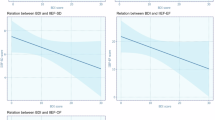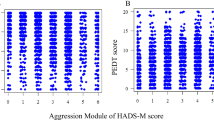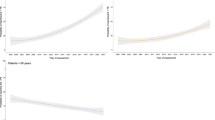Abstract
We aimed to assess the clinical characteristics of patients presenting for premature ejaculation (PE) as their primary medical complaint over a 15-year time frame. Data from 257 men seeking first medical help for life-long PE between 2008 and 2022 were analysed. Clinical data and serum hormones were collected in each case. At baseline all patients completed the International Index of Erectile Function (IIEF), the Beck Depression Inventory (BDI), and the Premature Ejaculation Diagnostic Tool (PEDT). Descriptive statistics and linear regression analyses were applied. Median (IQR) age at presentation was 32 (26–37) years, and PEDT, BDI and IIEF-Erectile Function (IIEF-EF) scores were 14 (11–17), 7 (1–11) and 19 (10–26), respectively. Of all, 182 (70.9%) patients reported some degree of erectile dysfunction according to IIEF-EF domain scores. Throughout the 15-year time frame, patient’s age at presentation significantly decreased over time (beta −0.4, p < 0.001). In details, patient’s age at presentation decreased by 1 year every two years of evaluation. Furthermore, depressive symptoms (beta −0.8, p < 0.001) and the severity of PE at presentation as scored with the PEDT (beta −0.5, p < 0.001) linearly decreased overtime. According to a 5-year group subdivision, age at presentation decreased from 2008–2012 to 2013–2017 (p = 0.04) and further decreased between 2018 and 2022 (p = 0.01). Similarly, baseline BDI scores significantly decreased from 2008–2012 to 2018–2022 (all p < 0.001). PE severity at first assessment was stable between 2008–2012 and 2013–2017 but decreased thereafter (p < 0.01). Patients in a steady couple relationship more frequently asked for medical attention for PE between 2018–2022 compared to 2013–2017 and 2008–2012 (72.0% vs. 43.8% vs. 51.6%, p < 0.001). In conclusion we showed that patients’ age has decreased over the last 15 years in men with life-long PE. PE severity and depressive symptoms at presentation showed a significant decline overtime. Men in a steady sexual relationship were more likely to seek medical attention for PE in recent years.
This is a preview of subscription content, access via your institution
Access options
Subscribe to this journal
Receive 12 print issues and online access
$259.00 per year
only $21.58 per issue
Buy this article
- Purchase on SpringerLink
- Instant access to full article PDF
Prices may be subject to local taxes which are calculated during checkout

Similar content being viewed by others
References
Salonia A, Bettocchi C, Boeri L, Capogrosso P, Carvalho J, Cilesiz NC, et al. European association of urology guidelines on sexual and reproductive health-2021 update: male sexual dysfunction. Eur Urol. 2021;80:333–57. https://doi.org/10.1016/j.eururo.2021.06.007
Saitz TR, Serefoglu EC. The epidemiology of premature ejaculation. Transl Androl Urol. 2016;5:409–15. https://doi.org/10.21037/tau.2016.05.11
Castiglione F, Albersen M, Hedlund P, Gratzke C, Salonia A, Giuliano F. Current pharmacological management of premature ejaculation: a systematic review and meta-analysis. Eur Urol. 2016;69:904–16. https://doi.org/10.1016/j.eururo.2015.12.028
McMahon CG, Jannini EA, Serefoglu EC, Hellstrom WJG. The pathophysiology of acquired premature ejaculation. Transl Androl Urol. 2016;5:434–49. https://doi.org/10.21037/tau.2016.07.06
Hobbs K, Symonds T, Abraham L, May K, Morris MF. Sexual dysfunction in partners of men with premature ejaculation. Int J Impot Res. 2008;20:512–7. https://doi.org/10.1038/ijir.2008.34
Cilio S, Pozzi E, Fallara G, Belladelli F, Corsini C, d’Arma A, et al. Premature ejaculation among men with erectile dysfunction-findings from a real-life cross-sectional study. Int J Impot Res. 2023;35:558–63. https://doi.org/10.1038/s41443-022-00601-4
Verze P, Arcaniolo D, Palmieri A, Cai T, La Rocca R, Franco M, et al. Premature ejaculation among Italian men: prevalence and clinical correlates from an observational, non-interventional, cross-sectional, epidemiological study (IPER). Sex Med. 2018;6:193–202. https://doi.org/10.1016/j.esxm.2018.04.005
Corona G, Rastrelli G, Limoncin E, Sforza A, Jannini EA, Maggi M. Interplay between premature ejaculation and erectile dysfunction: a systematic review and meta-analysis. J Sex Med. 2015;12:2291–300. https://doi.org/10.1111/jsm.13041
Rowland DL. Psychological impact of premature ejaculation and barriers to its recognition and treatment. Curr Med Res Opin. 2011;27:1509–18. https://doi.org/10.1185/03007995.2011.590968
Russo GI, di Mauro M, Cocci A, Cacciamani G, Cimino S, Serefoglu EC, et al. Consulting “Dr Google” for sexual dysfunction: a contemporary worldwide trend analysis. Int J Impot Res. 2020;32:455–61. https://doi.org/10.1038/s41443-019-0203-2
Gul M, Diri MA. YouTube as a source of information about premature ejaculation treatment. J Sex Med. 2019;16:1734–40. https://doi.org/10.1016/j.jsxm.2019.08.008
Serefoglu EC, McMahon CG, Waldinger MD, Althof SE, Shindel A, Adaikan G, et al. An evidence-based unified definition of lifelong and acquired premature ejaculation: report of the second international society for sexual medicine Ad hoc committee for the definition of premature ejaculation. J Sex Med. 2014;11:1423–41. https://doi.org/10.1111/jsm.12524
Charlson ME, Pompei P, Ales KL, MacKenzie CR. A new method of classifying prognostic comorbidity in longitudinal studies: development and validation. J Chronic Dis. 1987;40:373–83.
Symonds T, Perelman MA, Althof S, Giuliano F, Martin M, May K, et al. Development and validation of a premature ejaculation diagnostic tool. Eur Urol. 2007;52:565–73. https://doi.org/10.1016/j.eururo.2007.01.028
Rosen RC, Riley A, Wagner G, Osterloh IH, Kirkpatrick J, Mishra A. The international index of erectile function (IIEF): a multidimensional scale for assessment of erectile dysfunction. Urology. 1997;49:822–30. https://doi.org/10.1016/s0090-4295(97)00238-0
D’Elia C, Cerruto MA, Cavicchioli FM, Cardarelli S, Molinari A, Artibani W. Critical points in understanding the Italian version of the IIEF 5 questionnaire. Arch Ital Urol Androl. 2012;84:197–20.
Cappelleri JC, Rosen RC, Smith MD, Mishra A, Osterloh IH. Diagnostic evaluation of the erectile function domain of the international index of erectile function. Urology. 1999;54:346–51. https://doi.org/10.1016/s0090-4295(99)00099-0
Richter P, Werner J, Heerlein A, Kraus A, Sauer H. On the validity of the beck depression inventory. Psychopathology. 1998;31:160–8. https://doi.org/10.1159/000066239
Maggi G, D’Iorio A, Aiello EN, Poletti B, Ticozzi N, Silani V, et al. Psychometrics and diagnostics of the Italian version of the beck depression inventory-II (BDI-II) in Parkinson’s disease. Neurol Sci. 2023;44:1607–12. https://doi.org/10.1007/s10072-023-06619-w
Capogrosso P, Ventimiglia E, Boeri L, Pozzi E, Chierigo F, Schifano N, et al. Should we tailor the clinical management of erectile dysfunction according to different ages? J Sex Med. 2019;16:999–1004. https://doi.org/10.1016/j.jsxm.2019.03.405
Pozzi E, Capogrosso P, Boeri L, Cazzaniga W, Matloob R, Ventimiglia E, et al. Trends in reported male sexual dysfunction over the past decade: an evolving landscape. Int J Impot Res. 2021;33:596–602. https://doi.org/10.1038/s41443-020-0324-7
Capogrosso P, Ventimiglia E, Boeri L, Cazzaniga W, Chierigo F, Pederzoli F, et al. Age at first presentation for erectile dysfunction: analysis of changes over a 12-yr period. Eur Urol Focus. 2019;5:899–905. https://doi.org/10.1016/j.euf.2018.02.006
Verze P, Arcaniolo D, Imbimbo C, Cai T, Venturino L, Spirito L, et al. General and sex profile of women with partner affected by premature ejaculation: results of a large observational, non-interventional, cross-sectional, epidemiological study (IPER-F). Andrology. 2018;6:714–9. https://doi.org/10.1111/andr.12545
Teo CH, Ng CJ, Booth A, White A. Barriers and facilitators to health screening in men: a systematic review. Soc Sci Med. 2016;165:168–76. https://doi.org/10.1016/j.socscimed.2016.07.023
Boeri L, Pozzi E, Fallara G, Montorsi F, Salonia A. Real-life use of the eutectic mixture lidocaine/prilocaine spray in men with premature ejaculation. Int J Impot Res. 2022;34:289–94.
Chierigo F, Capogrosso P, Boeri L, Ventimiglia E, Frego N, Pozzi E, et al. Lower urinary tract symptoms and depressive symptoms among patients presenting for distressing early ejaculation. Int J Impot Res. 2020;32:207–12.
Author information
Authors and Affiliations
Contributions
LB wrote the paper, EP, FB, FC, SC, AB, MR, FN, CC, PC, and AD collected data; FM and AS supervised the paper, approved the final version of the manuscript. Data Availability: data are available from the corresponding author on reasonable request.
Corresponding author
Ethics declarations
Competing interests
The authors declare no competing interests.
Additional information
Publisher’s note Springer Nature remains neutral with regard to jurisdictional claims in published maps and institutional affiliations.
Rights and permissions
Springer Nature or its licensor (e.g. a society or other partner) holds exclusive rights to this article under a publishing agreement with the author(s) or other rightsholder(s); author self-archiving of the accepted manuscript version of this article is solely governed by the terms of such publishing agreement and applicable law.
About this article
Cite this article
Boeri, L., Pozzi, E., Belladelli, F. et al. The clinical profile of men with premature ejaculation at presentation has changed over the last fifteen years: picture from a longitudinal study. Int J Impot Res (2025). https://doi.org/10.1038/s41443-025-01013-w
Received:
Revised:
Accepted:
Published:
DOI: https://doi.org/10.1038/s41443-025-01013-w
This article is cited by
-
Men with delayed ejaculation report lower sexual satisfaction and more depressive symptoms than those with premature ejaculation: findings from a cross-sectional study
International Journal of Impotence Research (2025)



